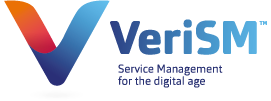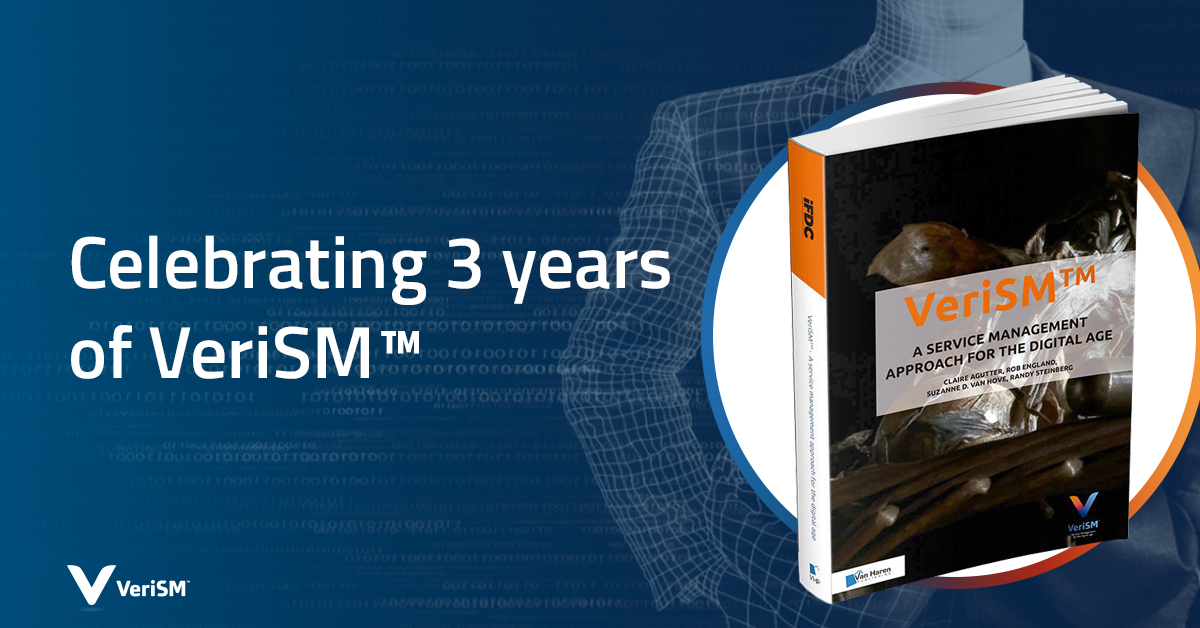On the 14th of December 2017, the first VeriSM book was launched. Representatives from the IFDC, Van Haren Publishing, and VeriSM contributors group converged on the itSMF Estonia conference to welcome VeriSM: A Service Management Approach for the Digital Age into the world.
Time has gone by quickly! It’s now three years since the book came out and a lot has happened in the Service Management world, especially for VeriSM. To celebrate the fact that it’s been three years since the book’s release and to take a look back, Sigrid Jansen invited Claire Agutter (VeriSM Chief Architect), Suzanne van Hove (Lead Author), and Johann Botha (Contributor and Author) to mark the occasion with an interview – and by raising a glass to the years to come!
Below you can find a summary of some of the topics covered during the interview. Prefer to watch it to see and hear everything for yourself instead? Then head over to the VeriSM™ ‘3 celebration’: interview session with Chief Architect and Lead Authors on the VerisM Playlist of YouTube.
What is VeriSM?
From the beginning, one of the most asked questions has been ‘What is VeriSM?’. It soon became apparent that this wasn’t merely because VeriSM was a new addition in terms of Service Management approaches, but also because it is very different from what was already out there.
The difference between VeriSM and other Service Management frameworks, methodologies and approaches is the reach. VeriSM is not intended only for IT professionals. VeriSM should be used by anyone in the business and as a result, is designed for the enterprise level.
Also, VeriSM doesn’t just reach further but it also covers a broader range of subject matter. As Johann Botha puts it during the interview: ‘VeriSM is really a fairly concise introduction to the topic of digital transformation and managing and providing good products and services within this new context.’
Suzanne and Claire both go on to further emphasize this unique ‘forward-thinking’ aspect of VeriSM. The approach doesn’t just look at one part of the business, but the entire organization. It doesn’t just look at service management in isolation but at the broader picture of end-to-end service delivery. It doesn’t just look at what resources you currently have, but beyond that to what you could add to bring value to the business. Suzanne explains: It’s a model that can be adopted or adapted to an organization as they look to exploit technologies and really ‘go digital’. It talks from end to end. From strategy into the delivery of services and what you can do.
The pivotal difference is that VeriSM has internalized the change that has been happening to companies over the past two decades. The fusion of business and IT may have happened gradually since the introduction of the personal computer, but it is no longer possible to deny that the digital landscape is now the default and IT is no longer just a department. Claire emphasizes this point: The big thing is that it steps away from this idea of IT and the business, and IT Service Management to a certain extent because if your organization relies on digital products and services, it relies on technology to keep the business moving. You can’t put the responsibility for that solely onto the IT department, it is absolutely an enterprise approach. It’s digital products, digital services and that’s really what makes it different, I think, to everything that’s out there.

Launch VeriSM book – itSMF Estonia December 2017
Who can benefit?
The two different books that have been published since the introduction of VeriSM have had two different target groups. The first book ‘VeriSM: A Service Management Approach for the Digital Age’ introduced the subject of Digital Transformation from a Service Management perspective. Through the lens of Digital Transformation, the book focused on applying Service Management across the enterprise. This is a great book for people who are new to ‘digital’ – in education or in industry. The book looks at the characteristics of ‘being digital’ or participating in or leading within the digital environment. The required skillset is different – it’s much broader and documents the ‘interpersonal development’ of technology. Once understanding those requirements, the basic model is provided and then the impact of the disruptive and emerging technologies and how they can be exploited to drive an organization forward in their digital transformation. It’s the foundational book and one that shouldn’t be overlooked in terms of understanding the change that has overtaken not only IT but also the entire enterprise.
With the publication of the second book ‘VeriSM: Unwrapped and Applied’ the authors explained the VeriSM model and how to apply it. The benefits for organizations are clear, Suzanne summarizes them neatly: I think the first half of Unwrapped and Applied […] looked at and focused on the strategic development of an organization and provided so many different ways to look at strategy that an organization would immediately benefit. They could find the bits and bobs that they needed to create the strategy before jumping into the second half of the book which was the actual day-to-day details, almost, of how to design that product and service and how to support it.
One of the points Suzanne stresses during the interview is that there has been some confusion around VeriSM and, specifically, the place it takes up in the existing ecosystem of frameworks, methodologies and approaches: The number one confusion is that VeriSM was a replacement. It was never designed to be a replacement for anything. It was designed to get you to think at the upper echelons of product and service delivery in a digital space. So it’s use whatever management methodology you’ve ever wanted to use, whatever would be applicable and useful and after that it’s a roll your own. I think that was the beautiful part of the book, it didn’t prescribe anything, except ‘have a strategy’.
The purpose of the first book was to answer the question ‘What does Service Management look like in the Digital Age?’ and to share the wealth of experience the contributors had to offer. After publication, the team behind the book received a lot of positive feedback and a lot of questions. Surprisingly, despite a focus on high-level information and non-prescriptive approaches, the main question being asked was ‘How do I do it?’. Claire shares ‘I think there’s a real misconception at the moment that people don’t want anything detailed. They just want high-level ideas. But what we actually got asked for was detail ‘How? What do I do? What first? What next?’. As a result of this desire for information, the author team added a lot of detail including case studies and practical information.
Even with the contributors that have already shared so much information, one of the unusual things about VeriSM is that the authors sometimes hear of unexpected ways in which people use VeriSM. An active community has sprung up around VeriSM which includes early adopters and VeriSM enthusiasts. A lot of people in this community are very keen to share the knowledge they’ve built up and new things they have learned or discovered during their own journey. One example is how David Barrow has used VeriSM in a very smart and intuitive way which led to Johann Botha organizing calls with David for his customers.
To find out more about David Barrow’s approach to using VeriSM, you can watch the ’10 Steps towards Successful Digital Transformation’ webinar which took place earlier this year.
Thank you to the community!
Since the introduction of VeriSM, a steady stream of examples and best practices have come from the community. The VeriSM Community is one that has grown along with the VeriSM Approach. With so many authors, contributors, and enthusiastic early adopters, it’s no wonder that the community is a vibrant one. A community that is also truly multifaceted with people from all kinds of professional backgrounds undergoing their digital transformation journeys all over the world. So far, there are VeriSM (certified) professionals in 56 different countries. At the end of the third year of VeriSM, we’d like to take a moment to thank everyone who has been part of the VeriSM community and wish them all the best of luck on their VeriSM journey.
If you’d like to join the VeriSM community, you can take part in the Official VeriSM Group on LinkedIn. You can also connect with or follow the experts that took part in the interview by looking them up below.
Connect with the Lead Authors:


